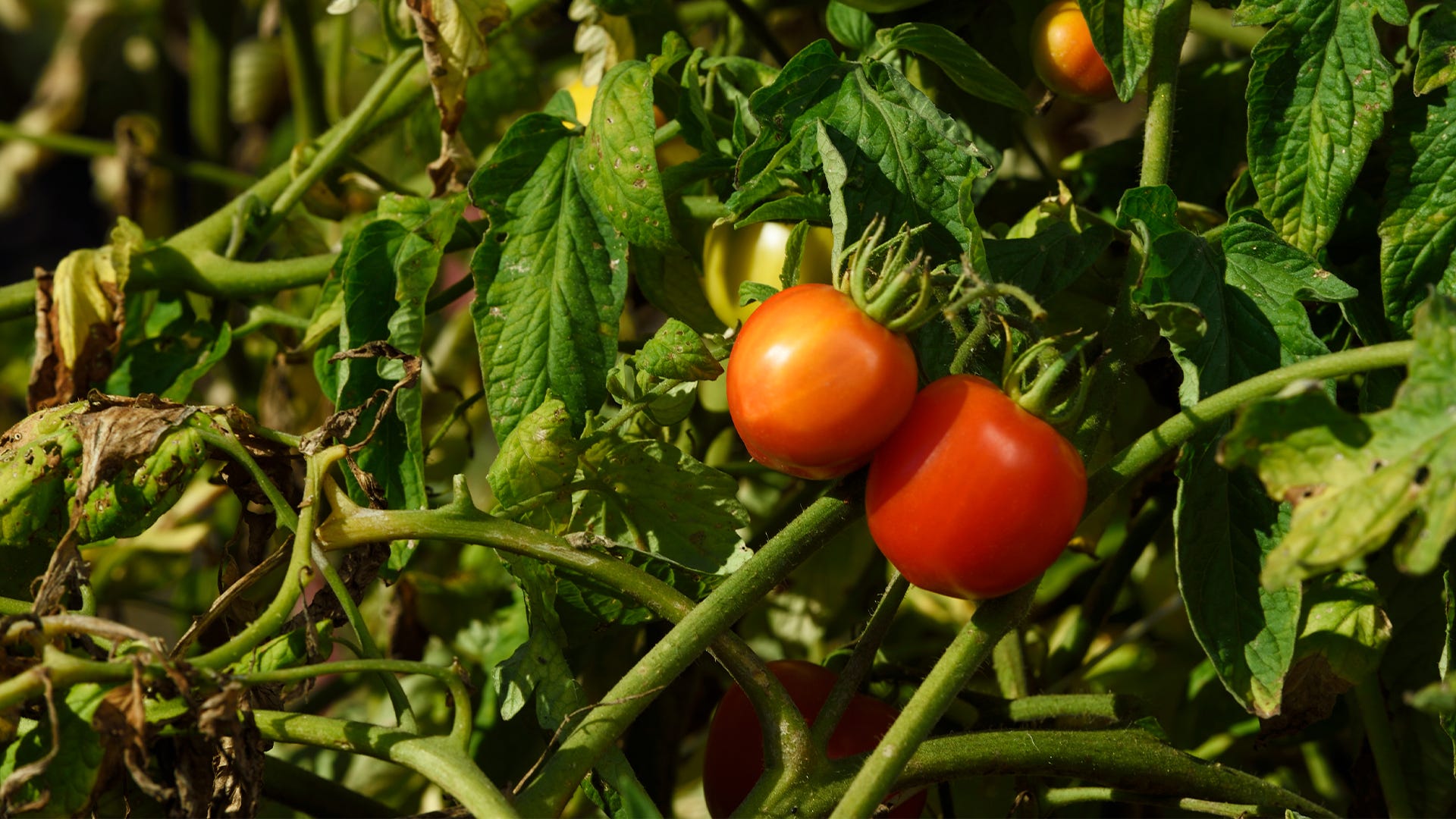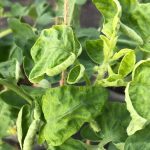White spots on tomato leaves can be caused by powdery mildew, a fungal disease. To fix it, use a preventative spray with sulfur or an organic fungicide, or create a mixture of baking soda and liquid soap in water to coat the plant thoroughly.
Ensure good air circulation and remove affected leaves, but do not remove more than a third of the plant’s leaves. Pruning can also help prevent powdery mildew. Additionally, a magnesium or calcium deficiency can cause white spots on leaves, so ensure proper nutrient balance.
In the battle to maintain healthy tomato plants, white spots on the leaves can be a frustrating and unsightly issue. These spots may indicate the presence of powdery mildew, a common fungal disease that affects many plants, including tomatoes. However, with the right knowledge and proactive measures, it is possible to address and prevent these white spots, ensuring strong and thriving tomato plants in your garden. We will explore the reasons for white spots on tomato leaves and how to effectively fix this issue to maintain the health and productivity of your tomato plants.

Credit: www.saferbrand.com
Understanding Powdery Mildew
Powdery mildew can cause white spots on tomato leaves, affecting plant health. To fix this issue, use preventative sprays with sulfur, organic fungicides, or a mixture of baking soda and liquid soap to treat the leaves and stems. Additionally, ensure good air circulation and remove affected leaves while keeping the plant dry to prevent the spread of the disease.
Causes Of Powdery Mildew On Tomato Leaves
Powdery mildew, a common fungal disease affecting tomato plants, is caused by the microorganism Erysiphe or Oidium species. This disease thrives in warm, dry conditions and is more prevalent in areas with high humidity and limited air circulation.Identifying White Spots On Tomato Leaves As A Symptom
The presence of powdery white spots on the upper and lower surfaces of tomato leaves indicates the onset of powdery mildew. As the disease progresses, the spots can merge, covering larger areas of the leaf surface. In severe cases, the entire plant may become affected, leading to stunted growth and decreased fruit production.Effects Of Powdery Mildew On Tomato Plants
Powdery mildew can impede the photosynthetic process of tomato plants, inhibiting their ability to produce and ripen fruits. Additionally, the weakened foliage is more susceptible to other diseases and pest infestations, thereby compromising the overall health and vitality of the plant. Regular inspection and prompt treatment are vital in preventing the spread and escalation of powdery mildew on tomato plants.`Preventive Measures For Powdery Mildew
Preventing powdery mildew on tomato leaves is essential to ensure healthy, thriving plants. By taking proactive measures, you can effectively minimize the risk of powdery mildew affecting your tomato plants. Below are some preventive measures that can help in the fight against powdery mildew:
Importance Of Regular Plant Maintenance And Hygiene
To prevent the onset of powdery mildew, regular maintenance and good plant hygiene are crucial. This includes removing any dead or infected plant matter, providing adequate space between plants for air circulation, and regularly cleaning and sterilizing gardening tools and equipment to prevent the spread of disease.
Using Preventive Spray Formulated With Sulfur
An effective preventive measure against powdery mildew is to use a sulfur-based preventive spray. This spray can help protect the plants from fungal diseases, including powdery mildew, by creating an inhospitable environment for the growth and spread of the fungi.
Consistent Monitoring And Early Detection Of Symptoms
Regular monitoring and early detection of powdery mildew symptoms are crucial in preventing the spread of the disease. Keep a close eye on your tomato plants for any signs of powdery mildew, such as white spots on the leaves, and take immediate action at the first sign of infection. This can help contain the spread and prevent further damage to the plants.
Treating White Spots On Tomato Leaves
To address white spots on tomato leaves, use preventive sprays with sulfur to ward off powdery mildew. In case of existing issues, apply organic fungicides or a mixture of baking soda and liquid soap to treat the leaves and stems.
Prune the plant to improve air circulation and bury affected leaves in the compost pile.
Organic Fungicide Applications For Treating Powdery Mildew
White spots on tomato leaves are often caused by powdery mildew, a common fungal disease. Organic fungicide applications can effectively treat powdery mildew. Look for a preventative spray formulated with sulfur to protect your tomato plants from this fungal disease.
Creating A Homemade Treatment Mixture Using Baking Soda And Liquid Soap
For a homemade treatment, you can create a mixture using a tablespoon of baking soda and a half-tablespoon of liquid soap in a gallon of water. Mix the solution in a spray bottle and coat the plant thoroughly to combat powdery mildew on tomato leaves.
Proper Plant Care Practices To Prevent Further Spreading Of Powdery Mildew
- Ensure adequate air circulation around the tomato plants.
- Remove and bury leaves with white spots in the compost pile to prevent the spread of the disease.
- Monitor and maintain proper watering practices to keep the foliage dry.
- Prune the plants to encourage growth and prevent powdery mildew recurrence.
Natural Remedies For Fungal Infections
When it comes to treating fungal infections on tomato plants, it’s essential to opt for natural remedies. These remedies not only effectively combat the issue but also promote organic and sustainable plant care practices.
Integrating Compost Extracts Or Teas As An Organic Treatment
Compost extracts and teas can serve as potent organic treatments for fungal infections on tomato plants. These natural solutions aid in bolstering the plants’ immunity and combating fungal diseases effectively. By enriching the soil and enhancing the plant’s natural defense mechanisms, compost extracts and teas offer a holistic remedy for fungal infections.
Creating A Preventative Solution Using Baking Soda, Vegetable Oil, And Mild Soap
One preventive measure for fungal infections involves creating a solution using common household ingredients. By combining a heaping tablespoon of baking soda, a teaspoon of vegetable oil, and a small amount of mild soap in a gallon of water, a powerful and environmentally friendly spray can be produced. This solution not only acts as a barrier against fungal infections but also nourishes the plants without causing harm to the environment.
Essential Steps To Stop The Spread Of Fungal Diseases On Tomato Plants
To prevent the spread of fungal diseases on tomato plants, it’s crucial to take proactive measures. Regularly monitoring the plants for any signs of infection, promptly removing affected leaves, and ensuring appropriate air circulation are paramount in halting the spread of fungal diseases. Additionally, maintaining optimal soil moisture levels and practicing good sanitation habits further promotes a healthy and disease-resistant environment for tomato plants.
Frequently Asked Questions Of Reasons For White Spots On Tomato Leaves (& How To Fix)
How Do You Treat White Spots On Tomato Plants?
To treat white spots on tomato plants, use a preventative spray with sulfur to prevent powdery mildew. You can also use organic fungicide or a mixture of baking soda and liquid soap in water. Remove affected leaves and ensure good air circulation to prevent the spread of the disease.
How Do You Treat White Spots On Leaves?
To treat white spots on leaves, use an organic fungicide or a mixture of baking soda and liquid soap in water. Ensure thorough coverage by spraying the plant. Provide good air circulation and address any nutrient deficiencies to prevent white spots on tomato plants.
How Do You Get Rid Of Spots On Tomato Leaves?
To get rid of spots on tomato leaves, pinch off affected leaves and bury them. Avoid removing more than a third of the plant’s leaves. Keep the leaves dry to prevent the spread of disease. Consider using organic fungicide or a mixture of baking soda and liquid soap.
How Do You Get Rid Of Fungus On Tomato Plants Naturally?
To naturally get rid of fungus on tomato plants, use an organic fungicide or create a mixture of baking soda, liquid soap, and water to spray the plants. Additionally, keep the leaves dry and consider adding compost extracts as a treatment.
Pruning for better air circulation can also prevent powdery mildew.
Conclusion
It is crucial to identify the underlying causes of white spots on tomato leaves and take appropriate measures to address them. By implementing preventive measures such as proper air circulation and using organic fungicides, gardeners can effectively combat fungal diseases and maintain the health of their tomato plants.
Regular monitoring and proactive treatment can help minimize the impact of white spots on tomato leaves, ensuring a bountiful harvest.

I am a graduate of Bangladesh Agricultural University, where I delved into various agricultural disciplines, equipping me with a profound understanding of agriculture. Beyond academics, I have hands-on experience in gardening and crop cultivation. My passion is to embrace sustainable farming and horticulture. With a BSc in Agriculture, I am dedicated to promoting environmentally conscious and efficient agrarian practices.
Bachelor of Science (BSc) in Agriculture (Hons.)
Master of Science. (Sustainable Agriculture & Food Security ) (MS)
Bangladesh Agricultural University




